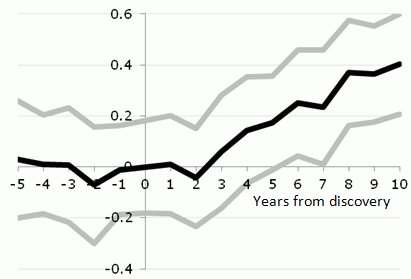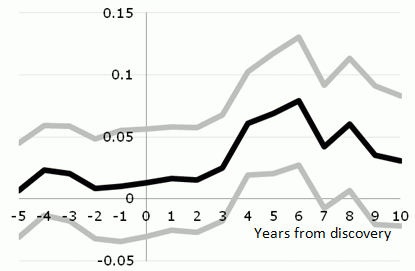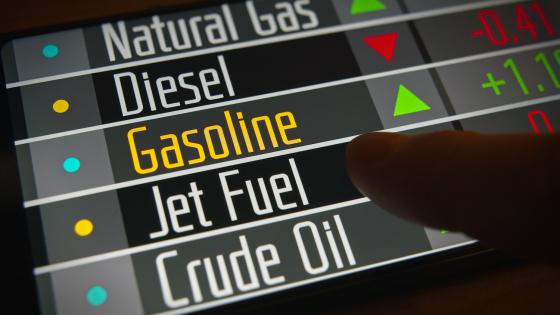Do natural resource windfalls, such as those arising from the discovery of giant oil fields, increase the risk of internal armed conflict? Anecdotal evidence from Nigeria, Angola, and Iraq leads us to suspect that they may, and recent research (Dal Bó and Dal Bó 2011; Besley and Persson 2009, 2011; Acemoglu et al. 2010) even sheds light on the mechanisms underlying some of these conflicts over resources. But as Norway, Canada, and Brazil show, not all oil-rich countries experience internal conflicts. Careful surveys of the literature on conflicts and natural resources (e.g. Ross 2004, 2006; Blattman and Miguel 2010) show how difficult it has been to quantify the effect of oil on armed conflict in all but a handful of countries. The goal of our research is to examine whether giant oil field discoveries really do fuel internal armed conflicts around the world, and if so, in which settings.
Identifying the effect of oil on conflict around the world
To investigate this question, we would ideally want oil windfalls to appear as if in a randomised-controlled trial. But in reality, of course, oil-rich countries differ from oil-scarce ones in ways that are difficult to observe and measure. Using data over time to control for fixed differences across countries is not straightforward either, because both the amount of oil extracted and its price may themselves respond to conflict. To overcome this challenge, we focus on the discovery of giant oil (and natural gas) fields, each of which contained ultimate recoverable reserves of 500 million barrels equivalent or more before extraction began (data on these giant oilfields are reported in Horn 2004). As we explain below, we find evidence that the timing of these discoveries is largely down to chance, so we can interpret the events that follow them as the causal effects of the discoveries.
Giant oil field discoveries increase oil production and oil exports
Our first finding is that, on average, oil production increases by about 35-50% within a few years of a giant discovery. As Figure 1 shows, giant oil field discoveries similarly increase oil exports by about 20-50% within just a few years.
Figure 1. The effect of giant oil field discoveries on per-capita oil exports
Note: Point estimates in black and 95% confidence interval in grey
But giant oil field discoveries also increase conflict incidence
As Figure 2 shows, we find that, on average, giant oil field discoveries increase the incidence of internal armed conflicts by about 5-8 percentage points within 4-8 years of discovery, compared to a baseline probability of about 10%.
Figure 2. The effect of giant oil field discoveries on the incidence of internal armed conflicts
Note: Point estimates in black and 95% confidence interval in grey
Giant oil fields fuel conflict in countries with previous political violence
We also find that the discovery of giant oil fields is especially likely to fuel internal conflicts in countries with recent histories of political violence. For example, as Figure 3 shows, giant oil field discoveries increase the incidence of internal armed conflict by about 11-18 percentage points (compared to a baseline probability of about 37-39%) when a country experienced at least one such conflict in the decade prior to discovery. The effect of discovery on the incidence of internal armed conflict is similarly 11-14 percentage points (compared to a baseline probability of about 19-20%) in countries that experienced at least one coup in the decade prior to discovery. By contrast, in countries that experienced no internal conflicts or coups in the decade before a discovery, there is no significant effect of giant oil field discoveries on the incidence of internal armed conflicts.
Figure 3. The effect of giant oil field discoveries on the incidence of internal armed conflicts in countries with at least one internal armed conflict in the previous decade
Note: Point estimates in black and 95% confidence interval in grey
Big prize, little gain
Turning to the effect of giant oil field discoveries on economic outcomes, we find that GDP per capita and government spending either increased modestly or remained unchanged within the decade following a giant oil field discovery. Our evidence also suggests that such discoveries did not affect private consumption or spending. In other words, most residents gained little (if anything) from the discoveries.
Robustness of our findings
If we could be confident that the timing of giant oil field discoveries within countries is random, then we could interpret what follows them as the causal effect of these discoveries. While we recognise that the search effort is not completely random, we argue that the precise timing of discoveries within each country is largely a matter of chance. To see why, consider how important giant oil fields are as a global source of oil and natural gas. Horn (2007) concludes that these giants account for over 40% of the world’s oil and natural gas reserves, so their discoveries are economically significant events. If a country or a firm could be fairly certain that a search will turn up a giant oil field, then they will most likely conduct the search. But in fact, giant oil field discoveries are very rare. Averaging across the world’s countries, the odds of a giant discovery in a given year is less than one-in-twenty. The fact that these events are so rare suggests that, even when search effort is involved, the precise timing is due less to planning and more to chance.
Our research provides additional evidence that addresses some potential concerns regarding the timing of the discoveries, and supports our interpretation that this timing is plausibly random. First, we address the concern that the discoveries may have resulted from economic or political changes that preceded them. As the figures above show, we find no evidence of significant economic or political changes in the five years leading up to giant oil field discoveries or in the year of discovery itself (a result which is consistent with a recent paper by Cotet and Tsui 2010). We also test whether discoveries follow lulls in prior conflicts, and find no evidence to support this hypothesis. Second, we tackle the concern that finding one giant oil field may lead to finding another nearby. While it is true that giant oil field discoveries in a country’s recent past increase the odds that it finds one in a given year, controlling for these past discoveries leaves the findings discussed above essentially unchanged. Our results are also robust to excluding observations within a decade or less of previous giant discoveries. Observations with giant oil field discoveries account for only about 1% of the remaining sample, making them especially difficult to anticipate. Third, we address concerns that economic or political conditions shortly before discovery may affect our estimates, by showing that our results are robust to controlling for institutional quality and aggregate private investment. Finally, we tackle the concern that observations with oil discoveries are different from others in ways that are difficult to measure directly. To do so, we compare the effect of giant oil field discoveries to the effect of smaller oil field discoveries, and find that our results still hold.
Policy implications
Our finding that giant oil field discoveries fuel internal conflicts in countries prone to violence has important implications for policy. For example, those who strive to reduce armed conflict should be concerned about oil rents that incumbents obtain in conflict-prone areas, especially if those rents encourage challenges to the incumbents’ power. At the same time, the firms that prospect for oil in conflict-prone areas and those who regulate them ought to be concerned about negative consequences for many locals, who have little to gain from giant oil field discoveries but may suffer from conflicts over the oil.
References
Acemoglu, Daron, Ticchi, Davide, and Vindigni, Andrea (2010) “A Theory of Military Dictatorships,” American Economic Journal: Macroeconomics 2010, 2:1, 1–42.
Besley, Timothy and Persson, Torsten (2009) “Repression or Civil War?,” American Economic Review, vol. 99(2), pages 292-97, May.
Besley, Timothy and Persson, Torsten (2011) “The Logic of Political Violence,” Quarterly Journal of Economics, forthcoming.
Blattman, Christopher and Miguel, Edward (2010) "Civil War," Journal of Economic Literature, vol. 48(1), pages 3-57, March.
Cotet, Anca and Tsui, Kevin K. (2010) "Oil and Conflict: What Does the Cross-Country Evidence Really Show?," Working Papers 201002, Ball State University, Department of Economics, March.
Dal Bó, Ernesto, and Dal Bó, Pedro (2011). “Workers, Warriors and Criminals: Social Conflict in General Equilibrium,” Journal of the European Economic Association, forthcoming.
Horn, Myron K. (2004) "Giant Fields 1868-2004 (CD-ROM)." Revision to 2003 version. Houston: AAPG/Datapages Miscellaneous Data Series. Version 1.2, 2004.
Horn, Myron K. (2007) “GIANT FIELD TRENDS-2: Giant fields likely to supply 40%+ of world's oil and gas.” Oil and Gas Journal 105.13.
Lei, Yu-Hsiang and Michaels, Guy (2011) “Do giant oilfield discoveries fuel internal armed conflicts?” CEPR Discussion Paper 8620. London, Centre for Economic Policy Research.
Ross, Michael L. (2004) “What Do We Know about Natural Resources and Civil War?” Journal of Peace Research, 41(3): 337–56.
Ross, Michael L. (2006) “A Closer Look at Oil, Diamonds, and Civil War.” Annual Review of Political Science, 9: 265–300.






